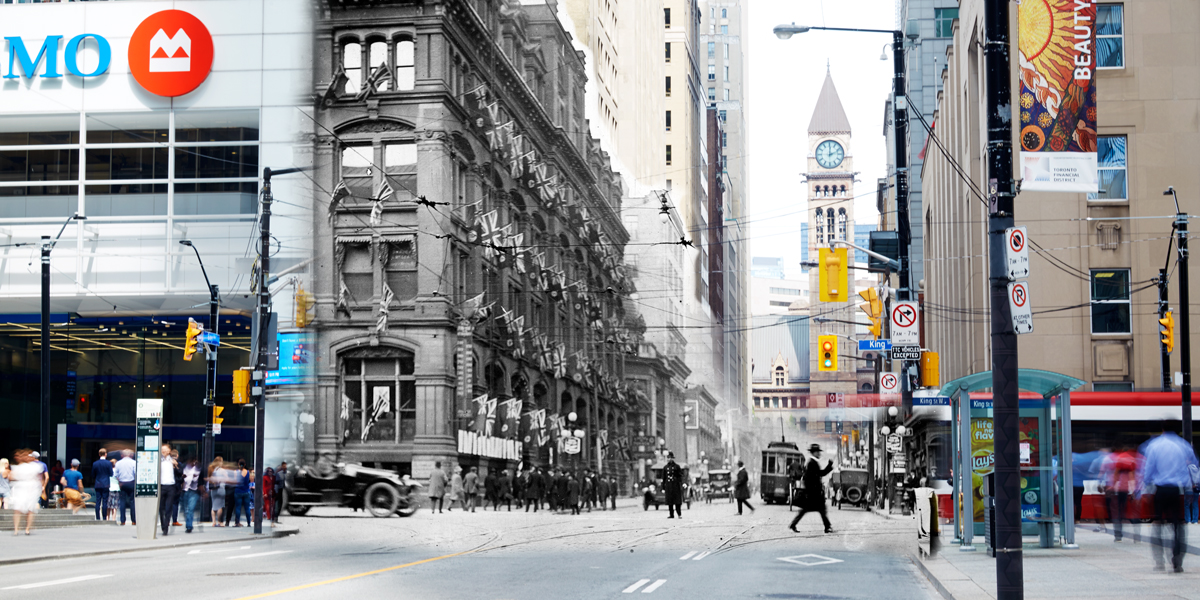“Globe & Mail Building” from the Present Past collection is focused on throughout the interview questions because it is the art piece planned for use in the social media posts.
TG: How long have you been a photographer?
EM: I have been working as a photographer for over 25 years. After graduating from Ryerson in 1991 I went on to work at a photographic supplier then as an assistant and studio manager/producer. During the latter I began working my way into the advertising industry and built up a client list. I worked as a commercial photographer in advertising until about 2015 when I redirected my career towards my artistic works.
TG: What inspired you to start photography?
EM: I was inspired by photography at an early age, I remember going to the school library in grade school and looking at Road&Track. I was transfixed by the images and it would stick with me. Once I reached high school I was burdoned with the task of deciding what career path I would endeavor. I wanted to feel inspired. Having been raised by two immigrant Italian parents, their ideas were of stable office work as an accountant or business admin. I raised the discussion that I wanted to live life as I go through it not when I retire. Working towards an office job I saw everything on a set path: graduate university, get a job, have a relationship, get married, buy a house, have kids and by 40 I would be jumping out of a plane, driving a sports car and trying to relive the youth I didn’t experience. I wantred more, I wanted to go into the arts. I loved what photography offered, a different perspective I could play with and explore. So many variables and tools to work with. Having come through the industry when it was film and paper I learned as much about the physics and chemistry as the artistic. This just gave me more tools to play with.
TG: You have a very unique collection out right now called Present Past which visualizes the changes that Toronto has gone through over the years, can you tell us a little about it?
EM: I wanted to create a series which would show generations old and new how Toronto has transformed. Many older structures have disappeared and some have survived. I want people to know the beauty that has escaped and appreciate what we have. The city will always transform, we can’t just tear down our history for the sake of more glass and metal towers.
TG: How long does it take to produce pieces like the ones in your Present Past collection?
EM: It’s a process that can take weeks for each image. From sourcing the original image, rephotographing the location (matching time of day, lensing and angle) then retouching. I will work with an image over the course of 1-2 weeks. I take my time to make sure all the elements work. There have been quite a few images that I have shot and realized when compositing the results fall short of my expectations. I see it as part of the exploration.
TG: What does the process look like for blending two very different photos together?
EM: It’s something that happens mostly in my mind’s eye. I try to perceive the different elements of the two separate images and see how I can have them interact. I look to have a multi-layered image which establishes the bygon era nestled within the blurred fast pace of modern times. It takes a lot of tweaking and finesse to blend the two in balance.
TG: How do you find or select the historical photographs? Are they curated from the Internet, old originals, etc.?
EM: I work almost exclusively with the City of Toronto Archives for the imagery. I have a few resources I use for information and research purposes. There are quite a few sites and image collections but it’s also about getting proper copyright releases and permissions. Not all sites allow images to be used for artistic purposes. My selection process is varied, some focus on historical buildings while others I select an area or street. I’ve produced a series along King St spanning from Bathurst to Church St with highlights of the Toronto Star and Globe & Mail buildings. Soon I will release a series of Queen St West. Sometimes I will focus on a selected location while others are discoveries while researching.
TG: Your piece “Globe & Mail Building” illuminates the changes that occured on King Street West during the 1970’s. Why choose the Globe & Mail building as the focal point of this particular piece?
EM: I actually began my focus on King St at Bay. This lead me to the Toronto Star building and the Globe & Mail was a natural follow up. I really appreciate older acrhitecture and the style of the curved Globe & Mail building let alone the art deco details. Older architecture had much more attention to detail in the aesthetic while also being functional. One can’t help but notice the different architectural styles over the years. There have been booms of construction in the city and I want to draw attention to some of the notable older architecture and historic sites before they are gone.
TG: What elements do you like the most about this piece?
EM: I have a definite affinity for the Art Deco stylized details, from the lettering to the clock to the curved corner. I think examples of every era should be retained to remind us of great design and the history this city has seen. Unlike the glass and metal non-descript towers imposing in our skyline.
TG: Do you ever have any setbacks capturing images like these?
EM: There are many images I have found that I cannot create a piece with. In some cases a street has been widened which makes it precarious at best to capture a long exposure. Some larger structures sit too close to match the original angle or it’s obstructed. The Harbour Commission building is a perfect example. I have found many images I would love to recreate but the towers built around it defy an effective angle. I appreciate the old photograph and keep searching.
TG: Present Past utilizes a lot of historical and significant Toronto buildings. Do these building have a significance to you personally?
EM: I grew up in Toronto and over the past 50 years I have seen a lot of change. Some buildings I choose are from memories and others are out of appreciation. Whether it’s their aesthetic or histrical importance I look to represent a crossection. As a child I explored much of the city as it related to my mother. I remember going down to the Postal Delivery Station on Bay, now the Scotiabank Arena, to pick up parcels from Italy. Weekends at Eaton’s on College looking at furniture. Part of this series is a trip down memory lane and on the other hand an exploration in what once was.
TG: What does the city of Toronto as a whole mean to you? Why is it worth the time to photograph?
EM: It’s a city that has grown too fast for people to realize how the developers and city officials have bulldozed a lot of the character and history out for the sake of profit. I want people to see what we have lost and the small part we have been able to retain. By creating this series I have brought about discussion and conversation. Hearing older generations share experiences and memories of a bygone era and the amazement of younger generations to know what has changed. I remember a time when the city felt like it was built to the scale of the people. Neighbourhoods were vibrant because of those who lived in them not because of real estate agents hyping certain areas. I grew up here as a result of my parents choosing to settle here after moving from Italy. My family home is still in the family after over 50 years. Change can happen fast so it’s important to document. Not everyone sees the city the same way. This is my interpretation to highlight the city of old and new.
TG: What can we expect to see from you in the future?
EM: I have a sketch book I try to keep by my side, filled with notes and thumbnail sketches etc. I constantly come up with ideas so it’s a question of what I can find time to execute. One project I am refining is a larger mixed media Limited Edition series of Present Past. I’ve already begun tests working through the bugs. This series will incorporate layers within resin, one of my favorite mediums. In the near future I will be publishing a new series highlighting Queen St. As the weather improves I already have a collection of images to continue this series with.
About
We conducted an interview with Ezio Molinari, one of our artists exhibiting in our Streets of Toronto Exhibit, January 2019. His photographs combine past and present buildings all over the city and we were honoured to have him in our exhibit.
Art
Falconer Hotel
Board Of Trade
KingBay, 1927
Queen City Oil Company
Toronto Star
Union Station







